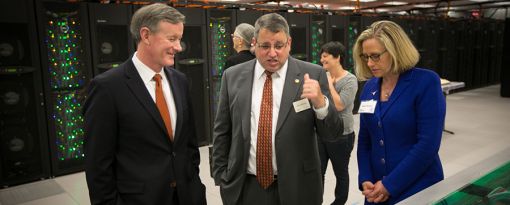Page title
The Future is Calling
Main page content
Listen to Chancellor McRaven discuss UT, supercomputing and why the world should be looking to Texas on the TACC podcast.
Yesterday, at UT Austin’s Texas Advanced Computing Center, I caught an inspiring glimpse of the future. I was there to help celebrate three important milestones: TACC’s 15th birthday, the dedication of its new Advanced Computing Building and, best of all, a $30 million award from the National Science Foundation to acquire and deploy a new supercomputing system called Stampede 2.
 Chancellor McRaven tours the Texas Advanced Computing Center’s new facilities with Dan Stanzione, TACC’s executive director,
and Maurie McInnis, executive vice president and provost of UT Austin.
Chancellor McRaven tours the Texas Advanced Computing Center’s new facilities with Dan Stanzione, TACC’s executive director,
and Maurie McInnis, executive vice president and provost of UT Austin.
It’s not every day you get a $30 million vote of confidence from the NSF, so I am eager to see the real, tangible benefits of what Stampede 2 will enable us to learn.
At TACC, it’s not just what’s being learned, but also who’s doing the learning that has me excited. There, high school students – the young minds upon whom the future of our state rests – have access to the same technology as Nobel Prize winners.
As they open up and democratize the process of scientific discovery, our investments in high performance computing have made our economy more competitive and our nation more secure.
But, it’s no secret that around the world, friends and foes alike are developing supercomputing strategies and making big investments.
At the risk of understatement, it is a competitive world out there, and as Will Rogers once said, “even if you’re on the right track, you’ll get run over if you just sit there.” Yesterday’s proceedings were proof positive that UT is not “just sitting there.” Quite the opposite.
We intend to lead. And we intend to win. But as I’ve said many times, if we’re going to maximize our contribution to Texas and the world, we need to take a collaborative approach. Far from dulling our competitive edge, in today’s complex, interconnected world, partnering is our competitive edge. We need to find great partners, and the only way to do that is by being a great partner.
It’s not every day you get a $30 million vote of confidence from the NSF.
So I am delighted that TACC is working with more than 400 institutions, in every field of science, including the humanities and digital arts. We are building the digital Team of Teams that will be necessary for us to excel now and in the future.
One thing I have learned since I first took a computer class at UT is that if you can see the patterns in ones and zeros, you can truly change everything about how we interact with the world.
Imagine what our future will look like as we continue to develop the incredible capability supercomputers give us to see patterns. We will see the hurricanes, the tsunamis, the tornados and earthquakes before they unleash their devastation. We will understand the spread of wildfires, the deadly viruses, and the mutation of genes. We will manage traffic in ways that save tens of thousands of lives every year. We will deliver precision medicine tuned to each individual’s unique biological make-up.
We will understand cause and effects in ways that seemed inconceivable just years before.
Answers to our most pressing questions lie in data. But data does not reveal itself easily. It takes lots and lots of computing power to see the simplest of patterns, the smallest of changes, and the finest of details.
Yesterday, at TACC, we took another giant step toward understanding the universe in which we live. I have no doubt that generations of Texans will look back on this moment and recognize the significance of our wonderful new facility.
Imagine the secrets that will be discovered, lying in the bits of data. Imagine the changes that will arise from those discoveries.
Imagine the future that we can create.
Thank you, as always, for reading. I’ll write again soon.
// // ]]>Learning about the powerful #supercomputers at the Texas Advanced Computing Center. pic.twitter.com/KSt9ydfio7
— Bill McRaven (@billmcraven) June 2, 2016

